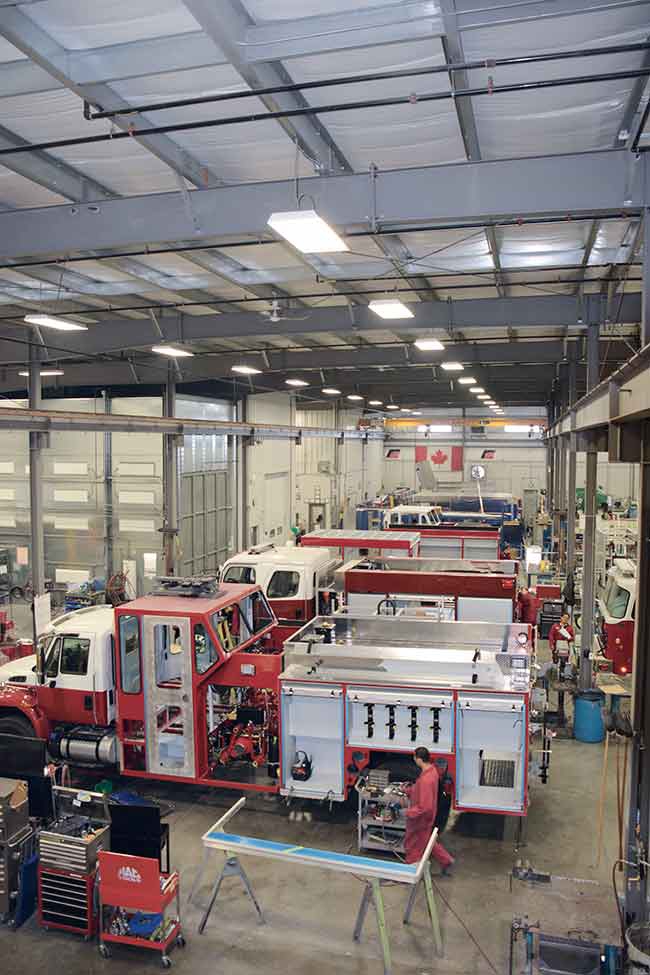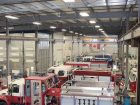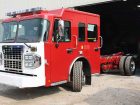
Equipment
Truck check
Imagine you just bought the perfect fire truck. Now, close your eyes for 10 seconds and really picture it.
November 11, 2015
By
Maria Church
 Fort Garry Fire Trucks There’s a lot that goes into buying a truck
Fort Garry Fire Trucks There’s a lot that goes into buying a truckWhat did it look like? What colour was it? What kind of engine? What features or equipment does it carry? How much did it cost?
So much goes into buying the perfect fire truck, not the least of which is a large quantity of money. It’s a happy moment for the crew when the truck finally rolls out and parks in the bay, ready for its first response.
But imagine that within the first few days, even hours, your perfect truck’s engine light turns on, the pump breaks, and the fuel gauge, radio, ignition shift switch and driver’s side lock all stop working.
That is what happened to a department in Nova Scotia a few years ago. A refurbished truck purchased from an out-of-province company arrived at the station unfit for the road.
“We noticed right away that there was stuff that was suppose to be on the truck that wasn’t on the truck,” recalls Dale Pettipas, who was on the truck-buying committee and is now chief of the department.
Thousands of dollars in repairs later, and no word from the company to cover the cost, the matter ended up in small-claims court. Despite winning the case, then Fire Chief Jamie Davidson said he doesn’t expect to ever see the money.
“With the cost of the lawyers and the stuff that we’d have to do,” he said, “we had to cut our losses.”
Can a department avoid those costly situations?
Preplanning your purchase
Do: Start by researching.
Victor MacPherson, who is a 15-year emergency-vehicle technician for the City of Vaughan, Ont., and a volunteer district chief in Adjala-Tosorontio, Ont., said the first step in his research is to determine budget and needs.
“You have to go to council. You have to find out: what do you have to spend and what are your limitations?” MacPherson said.
From there, he said, “Google is your best friend. Online it’s amazing what you can find.”
MacPherson recommends looking at top-of-the-line and middle-of-the-road products, but steering clear of junk that you might regret down the road.
Peter Lewko was behind truck purchases for the Town of Caledon Fire and Emergency Services in Ontario for about six years and is now retired. He suggests learning about and keeping tabs on manufacturers to know what products they offer from what suppliers.
“It can be a puzzle,” Lewko said, “and depending on who your manufacturer is they may have a huge range of suppliers and can offer you different products or they may be very restrictive.”
Brian Nash, national sales manager for Winnipeg-based Fort Garry Fire Trucks, recommends that researchers narrow in on manufacturers’ certifications and liability coverage.
“Are you dealing with a company that has certified engineers on staff, liability insurance, national safety marks? These are all things they should be looking for in a manufacturer,” Nash said.
Do: Take all opportunities to visit suppliers and manufacturers.
Even if you are not in the market for a new truck, meeting suppliers face to face to learn about new-product development helps to get the pulse of the industry, Lewko said.
Arrange tours of manufacturer facilities, he said, ideally with the chief or deputy, the member in charge of purchasing and a mechanical staffer. While its good to have more than one opinion, it’s also easy to have too many opinions, Lewko said, so limit the group to three.
If the manufacturer is footing the bill for the tour, be careful not to commit to a product beforehand.
“The manufacturer has to realize that you may or may not be purchasing from them,” Lewko said. “Don’t be pushed into something.”
Another option is trade shows. Fort Garry will visit between 25 and 30 trade shows across Canada each year.
“Most of our suppliers are present there as well,” Nash said. “So we can point people in the right direction; for more detailed info go see that guy in the Foam Pro booth or that person in the Federal Signal lighting booth.”
For smaller departments that don’t have the funds for travel to trade shows or manufacturing sites, Pettipas suggests staying local; it might up the price, but it will lower the risk if you can monitor the truck through the stages of manufacturing.
Don’t: Discount purchasing history.
Bear in mind, Lewko said, that a relationship and history with a specific dealer or manufacturer has value. It’s hard to fix a dollar figure on receiving immediate mechanical or parts service when a truck goes down.
Sticking with the same manufacturer also means having the same product line and parts supply, he said, which builds familiarity for the firefighters, training officers and mechanical staff.
“To bring something new in has a cost to it because now you have to re-train your trainers, firefighters and mechanics, you may have to buy specific diagnostic tools for that product and you will most likely have to stock different parts,” Lewko said.
Pino Natale, owner of Dependable Truck & Tank based in Brampton, Ont., who worked with Lewko, agreed with his emphasis on the benefits of purchasing history.
Once Dependable establishes a relationship with a department, Natale said, his staff can standardize future units to suit needs or likes.
“It’s especially helpful for volunteer departments, because it could be anyone on that truck at any time,” Natale said. “Even at different stations, if they need to operate the pump they are familiar with the trucks.”
Do: Turn to other departments.
Other fire departments are invaluable information resources. Don’t hesitate to reach out, MacPherson said, which can be as simple as asking the manufacturer for contact information from a recent delivery and calling up the chief.
“Ask them: are they happy with the truck? What’s the warranty like? What’s the repair like? What’s the availability of parts like? Any issues?”
Don’t: Ignore licensing, registration and traffic acts.
Research includes looking into licensing and registration, paperwork that Lewko said is all too often ignored until an apparatus is involved in a collision.
“All of a sudden everything comes into play and the ministry is inspecting the vehicle, the OPP are checking driver records and all of this kind of stuff,” he said. “If you don’t have those enforcements in play then you can run into trouble.”
As well, the federal government and provinces all have acts that regulate the standards on the road, including for municipal vehicles. In Ontario it’s the Highway Traffic Act from the Ministry of Transportation.
MacPherson said a chief must sign off on a vehicle that doesn’t meet the standards in the act, such as weight, and faces consequences if that vehicle is involved in an accident. That said, most, if not all manufacturers build to provincial standards, but make sure it’s written in the contract.
Do: Decide between RFP and tender.
A department next determines whether the specifications for the apparatus will be released to the dealers and manufacturers as a request for proposal (RFP) or a tender.
“An RFP allows the purchaser to entertain suggestions from the manufacturer,” Lewko said. “We used the RFP process with some restrictions built into the document.”
When you score the RFP, the purchasing power is most often the biggest piece of the pie, he said.
“Even though a supplier may score very high with regards to the specs that we want – it’s the engine we want, it’s the transmission we want and it’s the chassis we want from company A – company B comes meets the specs with different products and comes in with a really low purchasing price,” Lewko said. “The municipality’s purchasing process, through the scoring of the documents, may then dictate that you purchase the apparatus from company B.”
A tender, which is legally binding, allows departments to specify exactly what they are looking for, but it means that lowest bid wins, which can be at the expense of quality, MacPherson said.
Manufacturers such as Fort Garry don’t usually care one way or the other, Nash said, but an RFP gives everyone more flexibility.
“A request for proposal or request for quotation gives the hammer to the fire department because they can see the end price and the specification, but they can pick up the phone and negotiate,” Nash said.
Purchasing the truck
Do: Require a pre-construction meeting.
When buying new, a meeting, face to face with manufacturer representatives is the best way to avoid any miscommunication or misinterpretation, Lewko said.
“A pre-construction meeting would be scheduled once the award was given,” he said, “then we would meet with the manufacturer’s staff and go through the specs, line by line, and the drawings to make sure that what we wanted was what the manufacturer was willing to deliver.”
For Fort Garry, Nash said, the pre-construction meeting is more important than a final inspection; so if a purchaser has funds for just one trip, sooner is better than later.
“If everyone isn’t on the same page before you build the trick, you’re going to have a lousy final inspection because there is probably going to be something missing; and this all costs money,” Nash said.
Buying used or refurbished typically won’t involve a pre-construction meeting, but Davidson recommends asking for plenty of pictures, or better yet visiting the manufacturer, before signing the purchasing agreement.
Do: Spec inspection requirements.
Lewko said his RFPs would include at least four inspections of the truck: a chassis inspection, a fire-body inspection, pre-paint inspection and a final inspection.
“We also required one of us to be present during the pump test,” he said. “And we were very specific that it had to be ULC (Underwriters’ Laboratories of Canada) tested and to have their ULC plate attached to the pump panel of the apparatus.”
Finding issues during the inspections, or parts of the truck that won’t meet your needs, is part of the manufacturing process, Lewko said.
Caledon’s past practice was to charge the costs of those inspections to the dealer or manufacturer, he said, but the municipality recently chose to absorb those costs in order to make the bidding process more fair.
A few months ago Dependable began a mandatory photo-inspection program. The company now sends pictures of every stage of production to customers for review.
“It actually is a life saver for both parties,” Natale said. “Chiefs know this project, and when we’re building 20 at a time, there could be a little slip up and a chief can point out: ‘I didn’t ask for this, or it’s missing this.’ ”
Don’t: Accept a third-party inspection, unless trusted.
Some trucks, such as those purchased from international companies, require testing to Canadian safety standards, which could mean extra money and time before the truck is ready to hit the road.
To avoid miscommunication, MacPherson suggests writing in requirements for NFPA standards and ULC testing. For used vehicles, he said, it’s a good idea to require a trusted third-party inspection to have everything tested. If the manufacture doesn’t agree, it’s a red flag.
The NFPA has guidelines for apparatus specifications as well as refurbished vehicles.
Don’t: Opt for a general inspection.
During each buyer inspection, go through the spec line-by-line, Lewko said. “Make sure that everything you want is there.”
Having mechanical staff there is essential if you are not well versed in truck mechanics.
“It could be little things,” Lewko said, “like the way some of the wiring is run throughout the fire body; it may be too close to something and over time could rub through, or something like that.”
Those changes can be easily made in the manufacturing process, he said, but if you wait until the truck is in service and find things wrong, it’s more difficult and more money to fix.
When a used or refurbished truck arrives, Pettipas said, make sure you are ready to inspect it then and there.
“Take somebody who might have more experience running a truck or from a bigger department or mechanically inclined and can inspect the truck,” he said.
Do: hold back payment.
Lewko said his hold back was at least 50 per cent until delivery, or at least certain stages of the manufacturing process. If the truck arrived and was not what the manufacturer promised, he said, he wouldn’t hesitate to hold back payment.
MacPherson said it is common to agree on penalties in the purchasing contract for not meeting requirements, such as a deduction in cost for every month the truck is not delivered past the pre-determined deadline. But it must be written in the contract to be official.
Smaller departments should also consider hold backs on used vehicles of at least 10 to 15 per cent, Davidson said. His department did hold back $7,000 when the vehicle arrived at the station and was visibly unfit for the road, but it was a split-second decision. And the $7,000 was less than half of what the repairs eventually cost.
“I believe it was around $16,000 to $17,000 to get it on the road,” Davidson said, “We couldn’t even get the company to give us a bill of sale. We ended up going to court to prove the truck belonged to us.”
The hold back should have been written into the purchasing contract, he said, especially because they are a small department must take the manufacturer’s word for the truck’s condition.
Pettipas has similar regret, but is also resigned.
“I don’t know if there is any way you can be sure you’re not going to get into the situation like we got into because you can only go by what the company tells you,” he said.
As MacPherson said, sometimes it boils down to buyer beware.
“If you don’t have a good feeling about it, there is a reason why,” he said.
“Just be cautious,” Pettipas said.
Print this page



